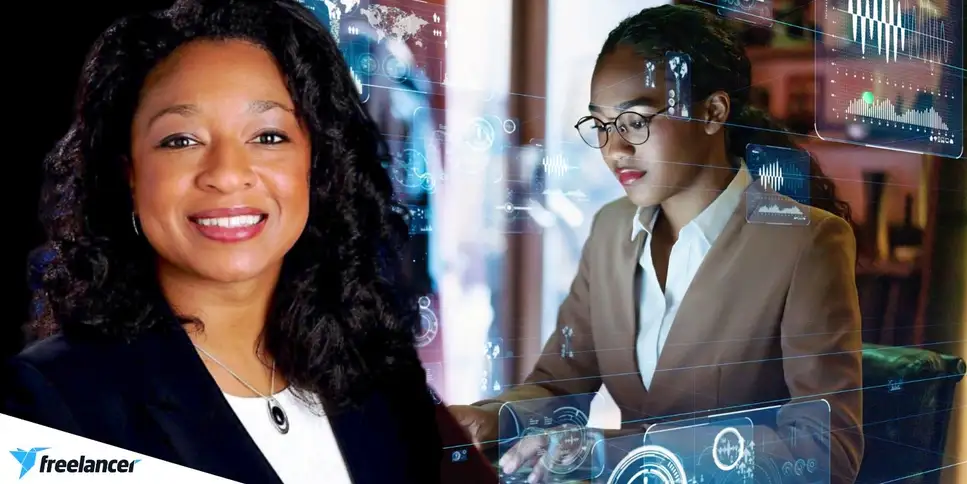Chat with Ava - Your AI Business Consultant
Hi I'm Ava, your AI guide to supercharging your business!
Whether you're already running a business or dreaming of starting one, I'm here to help turn your vision into reality using AI powered freelancers. Share your business goals, and together, we'll create a project that our talented freelancers can bid on. Let's make your vision a reality!
I have a business
I'm starting a business
Something went wrong while sending the conversation to your email. Please try again later.
You can only save your conversation once per hour. Please try again later.
Your conversation is too short. Keep chatting with Ava to enable saving.
Celebrating International Day of Women and Girls in Science with Dr Christyl Johnson
This International Day of Women and Girls in Science we're celebrating Dr Christyl Johnson's efforts to empower girls and women in the field of tech.
Feb 13, 2020 • 3 minute read
E
Closed User
Copy to clipboard failed, please try again after adjusting your permissions.
Copied to clipboard.

A celebration of Dr Christyl Johnson's amazing efforts to empower girls in tech
To commemorate this International Day of Women and Girls in Science, we talked to Dr Christyl Johnson, the Deputy Center Director for Technology and Research Investments at NASA, about the work she's doing to empower girls in STEM.
We sat down with Dr Christyl Johnson at Startcon 2019 to discuss her initiatives to get more young girls interested in science and technology.
The problem
Simply put, there just aren't enough women in tech. Even though it's a secure career choice and the demand for skilled technical professionals is expected to boom in the near future , young girls aren't choosing it as a career path.
Just take a look at the numbers :
In 2015, only 18% of women graduated in computer science and 20% in engineering.
In 2016, 12.6 % of bachelor degrees in science and engineering were awarded to women.
Only 8% of girls choose to enroll into an engineering degree
According to Dr Johnson, the current education system is not helping.
"So many times our young girls are discouraged from pursuing tech" she says "Even in the classrooms, the teacher's examples are often geared towards the boys. So it's not something that young girls can connect with."
Even if a girl does pursue a career in tech, women are 41% more likely to quit than men.
Something definitely needs to change. Dr Johnson is working to encourage girls to not only choose a tech career, but to stick with it.
Dr Christyl Johnson's solution
Dr Johnson welcomes girls into NASA headquarters to give them hands-on experience with science and tech.
"I take it upon myself to reach out to young girls and I have a STEM girls night in" she says "I host a slumber party at NASA and I invite about 60 girls"
But Dr Johnson doesn't always select the top STEM performers for these expeditions. She makes an effort to reach out to the girls who have little STEM background.
"These girls aren't A or B students. They're C students that have given up on their ability to do this stuff," Dr Johnson says.
Dr Johnson then pairs each girl with a female college mentor as well as a female NASA employee to help build their burgeoning interest in science and technology.
"And so we pair up those high school girls with college age girls for near to peer mentorship" she says "then I pair that pair with a NASA woman. And that NASA woman follows them along their trajectory, through college and all, so that we can help them with some of those hard choices that they have to make."
These mentoring programs have completely transformed the mindsets of girls who would have otherwise never pursued a career in tech, Johnson says.
"They say to me, 'I could never do this stuff,' but I say to them, 'Yes you can. Let me show you.'"
Dr Johnson says any young woman on the fence about pursuing a career in STEM should take the leap.
"She absolutely should do it! It's just a matter of getting her to a place where she is confident enough in her ability," Johnson says.
Final thoughts
Dr Christyl Johnson's initiative is introducing a wider array of creative expression into the tech landscape, so on this International Day of Women and Girls in Science, we'd like to thank Dr Johnson for empowering young women to lead the way in science and technology.
Tell us what you need done
Enter your project name
Related Stories
Talk to one of our Technical Co-Pilots to help with your project
Recommended Articles Just for You

If your creativity needs a jump start follow Dr Christyl Johnson's tips to get back on track fast
4 min read

Artificial Intelligence technology is nothing to be afraid of. We'll show you how to use it to transform your startup
7 min read

Struggling to come up with the best idea? Our exhaustive guide runs through the idea generation process to help you tap into your inner Steve Jobs.
10 min read

Got a great idea for an app? Need a new way to grow your business? We tell you everything you need to know about building a mobile app in 2020.
16 min read
Thanks! We’ve emailed you a link to claim your free credit.
Something went wrong while sending your email. Please try again.
Loading preview
Permission granted for Geolocation.
Your login session has expired and you have been logged out. Please log in again.




